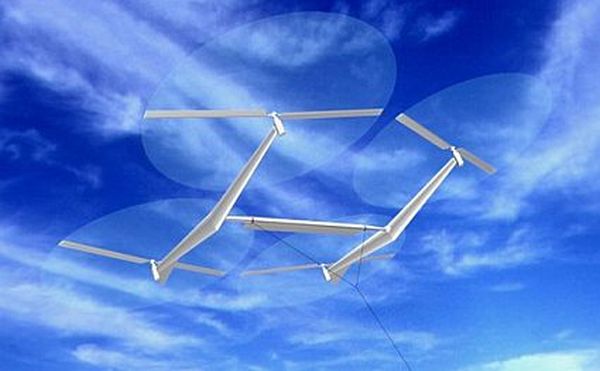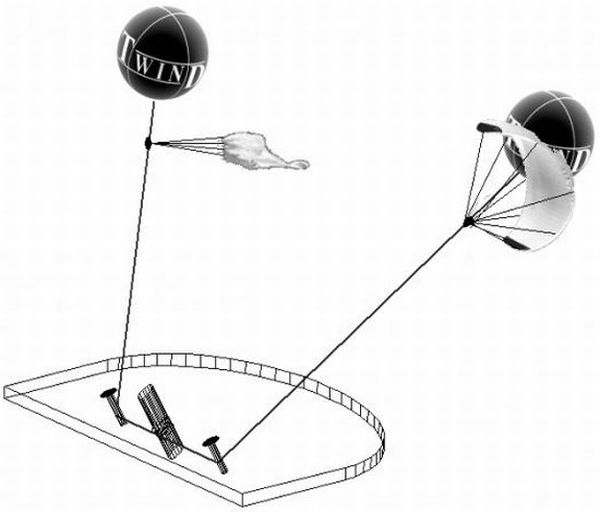When people talk about alternate energy, the two sources that readily come to mind are wind and solar energy. While the use of solar energy has grown in leaps and bounds in the last decade or so, wind energy has just not received the same mainstream attention. That is despite total wind energy production in the world growing from 17.4 GW in 2000 to 175 GW in 2010. A whooping tenfold increase in a decade and still people are happier going solar than turning toward wind power. There are valid reasons though for this bias. Solar Energy is predictable and highly reliable, while wind energy ebbs and flows with changing seasons and even changing hours in a day.
Reliability is a key factor in alternate energy sources and wind energy just does not promise any of it. But, High Altitude Wind Power (HAWP) promises to correct the current uncertainty and lend more credibility to wind power. At higher altitudes the winds are gustier, predictable and produce energy that is on an average 16 times greater than at ground level. By using windmills at these altitudes that are tethered to ground so that they can relay power, one can power the entire planet on wind energy alone. But is it really possible?
The Next Big Thing
Altaeros Energies’ Airborne Wind Turbine

Altaeros Energies is already busy creating this innovative wind turbine that will float away at higher altitudes and tap into wind energy with ease. The structure of this high altitude wind turbine is deceptively simple as they fitted a giant turbine to a helium filled shell, which helps take it to the altitude of your choice. The company has already tested a scaled down prototype, which successfully produced power from altitudes of 350 feet above ground. Now we are just waiting for the real deal.
Flying Electric Generator

Being developed by Sky WindPower, these ‘Star Wars like’ turbines wlll be mounted on a giant H-shaped platform and will be hovering at altitudes of 15,000 to 30,000 feet above ground, depending on optimum wind conditions. Each H-shaped platform will sport four 130 foot diameter rotors and the entire unit will be connected to a base on ground using an aluminum cable that also transfers the power generated. Sky WindPower wishes to create an aerial grid that will house several such platforms and the area would be declared as a no fly zone.
Energy Harvesting Kites

Makani Power seems to have a simpler and much uncomplicated approach to tapping into high altitude wind power. They just want to use a series of giant kites that will be attached to a conducting cable to generate electricity. These kite strings will be held by robots on ground and while the energy producing mechanism here is still unclear, it seems like their vision is based in tradition.
NASA plans off-shore airborne wind turbines like TWind

High Altitude Wind Power has already some backers at NASA with plans that mainly revolve around off shore airborne wind turbines, which will not invade the airspace of both commercial flights and those of the U. S. Air Force. Of course this presents with a problem of transferring this energy from off shore ocean stations to land. That is what some at NASA are working on along with a proposed system like TWind. The system will sport two giant balloons that will have giant sails and float at altitudes of 2,600 feet above ground and transfer energy using nanotube tether cables.
The Windward Side
We have already touched upon many of the advantages that come along with high altitude wind power. Most important of them all is the consistency in energy production. With steady winds all through the year, energy can be constantly produced at more or less the same rate. Also the energy output is several fold compared to the energy produced by turbines on ground. As wind energy increases at a rate which is cube of wind velocity, a three time increase in wind speed will produce 27 times more power. Also, in a world where land is a precious resource, the windmills themselves will need none whatsoever.
The Leeward Side
There is definitely one big hindrance to this technology and that is the management of air space. This is in addition to the fact that we need to still make several breakthroughs before we can safely capture wind energy at high altitudes and then efficiently send it back to earth. The entire set up will also be very expensive and would take complete state backing to achieve.
The Road Ahead
There is no doubt that statistically speaking, if we can tap into high altitude wind power, then we can power the entire planet just on it and nothing else. But realistically, we have a long way to go before we can even generate considerable energy using this method. Scientific breakthroughs combined with strong intent could see HAWP become a reality in the next couple of decades. And once the first wind turbines start floating over our heads, expect many more to quickly follow to cash in on the green and clean riches.




